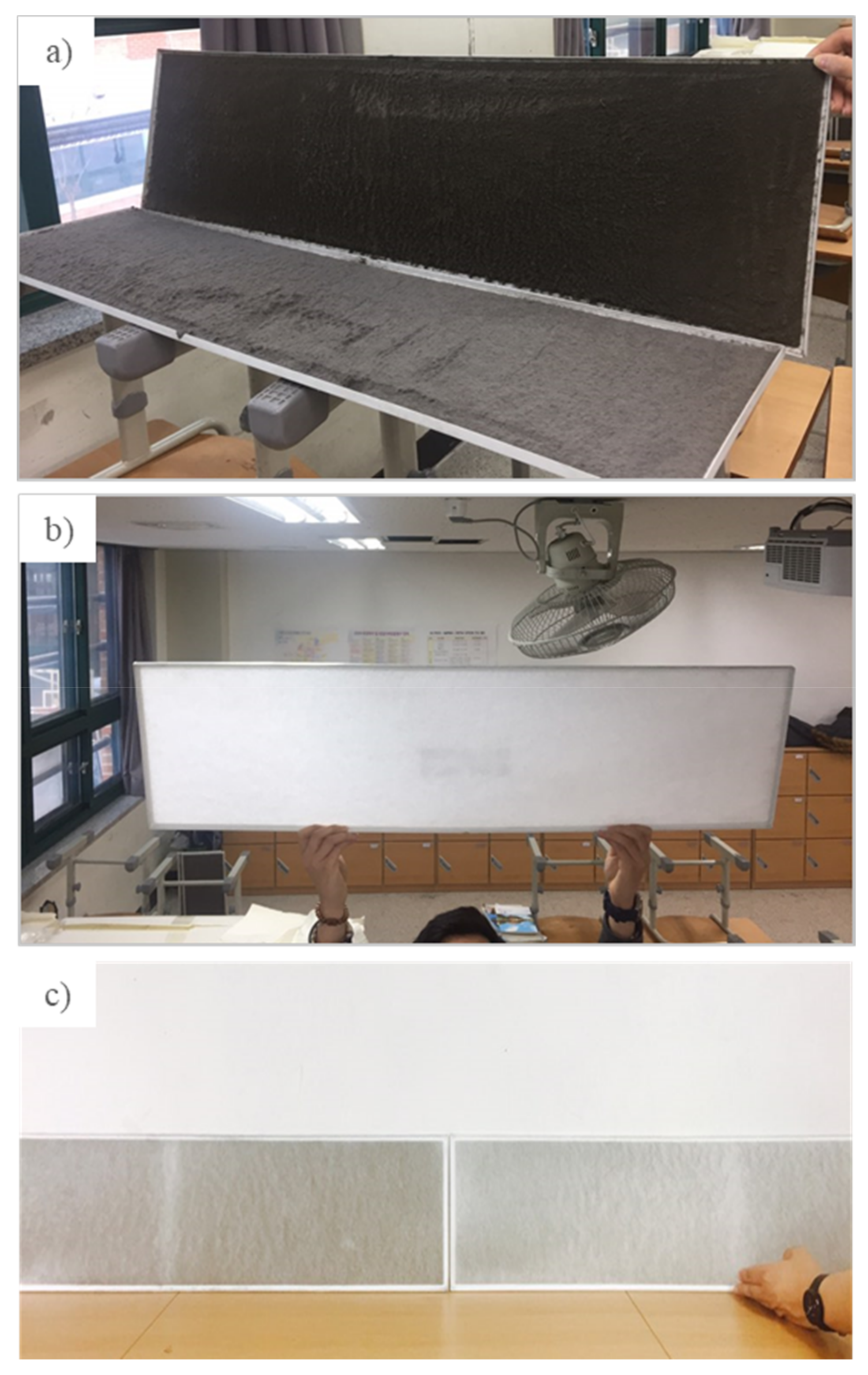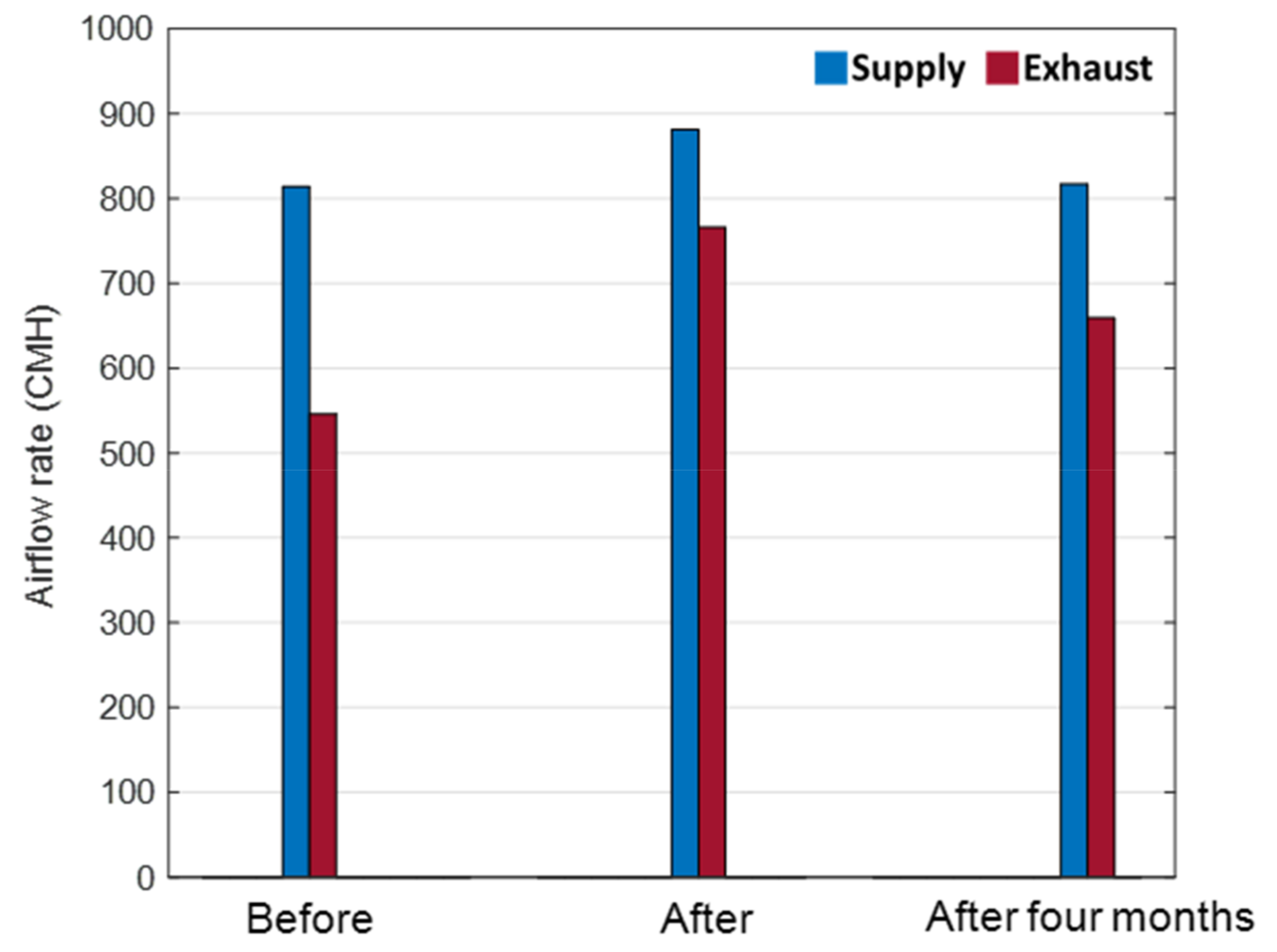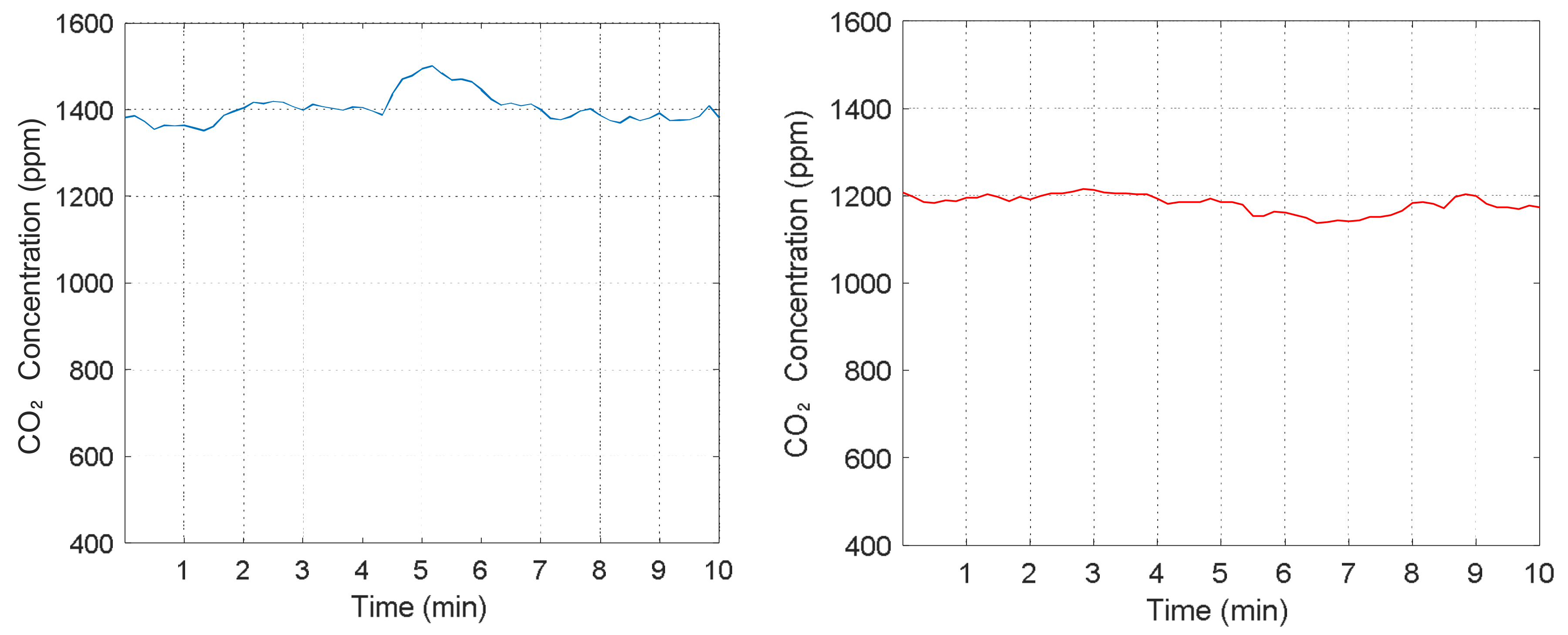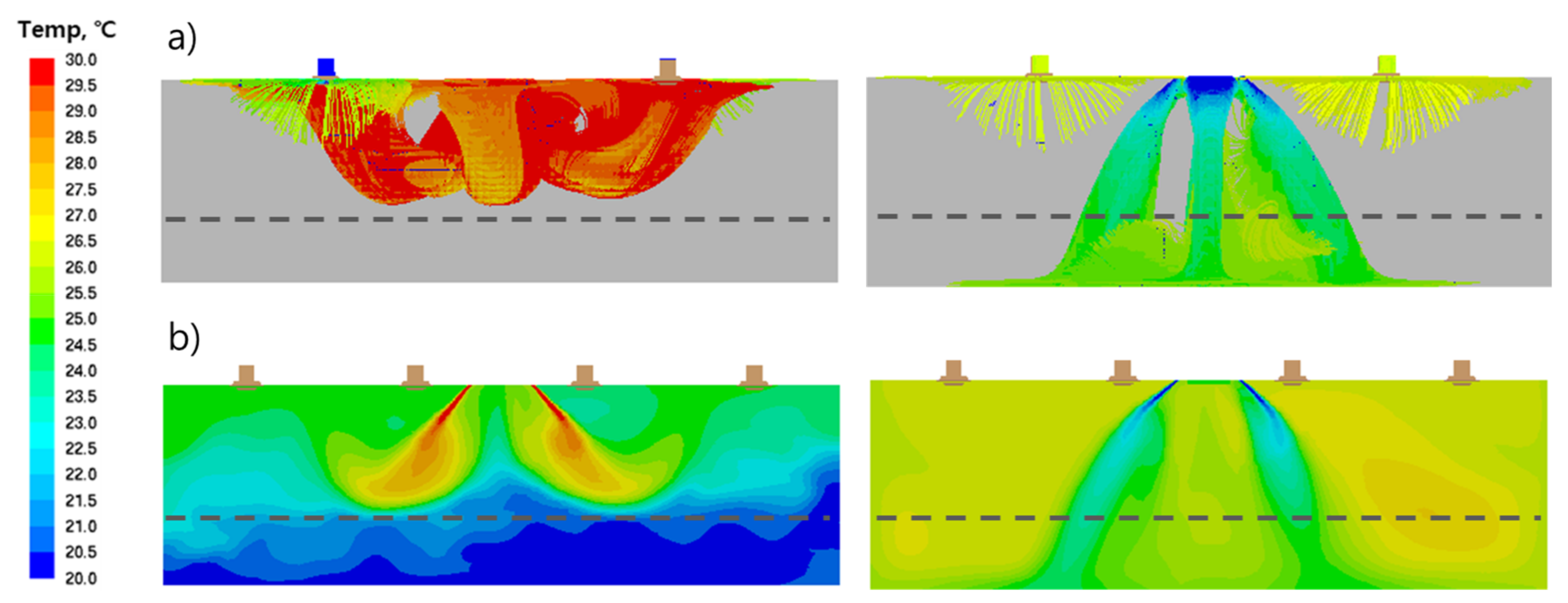Effects of ERV Filter Degradation on Indoor CO2 Levels of a Classroom
Abstract
:1. Introduction
2. Filter Degradation over Time
2.1. Description of Test Classroom
2.2. Measurement of Air Volume Flow Rates According to Filter Degradation
3. Analysis Methodologies for Adjusting Measured CO2 Results
3.1. Mass Balance According to Ventilation Rates
3.2. Evaluation Method of the CO2 Emission Rate per Student
3.3. Computational Fluid Dynamics Analysis
4. Results
4.1. Air Volume Flow Rate Measurement
4.2. CO2 Level in the Classroom after Filter Replacement
4.3. CO2 Level Comparison between Cases of before and after Filter Replacement
4.4. Analysis Methodologies I: Number of Students
4.5. Comparison of Cases after the Filter Replacement and Four Months after the Replacement
4.6. Analysis Methodologies II: EHP Operation Mode
5. Conclusions
- The air volume flow rates increased after the filter replacement by more than 200 CMH at the exhaust air side of the ERV.
- The air volume flow rates decreased as time elapsed since the filter replacement.
- The resulting indoor CO2 levels were affected by the measured air volume flow rates when the test conditions were similar.
- After the filter placement, the value of indoor CO2 concentrations was decreased by more than 300 ppm, showing 1085 ppm, sufficiently meeting the national recommended value.
- The PSO gave a value of 0.0148 CMH for the CO2 emission rate per student, which is within the standard ranges proposed by ASHRAE.
- The CFD simulation can give different airflow patterns in heating and cooling conditions, and this result can be used for interpreting the CO2 concentration measured at a single measuring point.
Acknowledgments
Author Contributions
Conflicts of Interest
Nomenclature
| V | Volume of the classroom (m) |
| C | CO2 concentration in the room (ppm) |
| Co | Outdoor CO2 concentration (ppm) |
| Ci | Indoor CO2 concentration (ppm) |
| Cin | Initial CO2 concentration in the room (ppm) |
| CC | Correction coefficient |
| CMH | cubic meter per hour (m3/h) |
| Ventilation air volume flow rate (m3/h) | |
| Infiltration air volume flow rate (m3/h) | |
| N | Number of occupants (-) |
| E | CO2 emission rate per student (L/s) |
References
- McQuade, J. A System Approach to High Performance Buildings; Technical Report; United Technologies Corporation: Washington, DC, USA, 2009. [Google Scholar]
- Apte, M.G.; Fisk, W.J.; Daisey, J.M. Associations between Indoor CO2 Concentrations and Sick Building Syndrome Symptoms in US Office Buildings: An Analysis of the 1994–1996 BASE Study Data. Indoor Air 2000, 10, 246–257. [Google Scholar] [CrossRef] [PubMed]
- Seppänen, O.; Fisk, W.; Mendell, M. Association of Ventilation Rates and CO2 Concentrations with Health and other Responses in Commercial and Institutional Buildings. Indoor Air 1999, 9, 226–252. [Google Scholar] [CrossRef] [PubMed]
- Clausen, G. Ventilation Filters and Indoor Air Quality: A Review of Research from the International Centre for Indoor Environment and Energy. Indoor Air 2004, 14, 202–207. [Google Scholar] [CrossRef] [PubMed]
- Csobod, E.; Annesi-Maesano, I.; Carrer, P.; Kephalopoulos, S.; Madureira, J.; Rudnai, P.; de Oliveira Fernandes, E.; Barrero-Moreno, J.; Beregszászi, T.; Hyvärinen, A. SINPHONIE: Schools Indoor Pollution & Health Observatory Network in Europe; Final Report; Publications Office of the European Union: Luxemburg, 2014. [Google Scholar]
- Satish, U.; Mendell, M.J.; Shekhar, K.; Hotchi, T.; Sullivan, D.; Streufert, S.; Fisk, W.J. Is CO2 an Indoor Pollutant? Direct Effects of Low-to-Moderate CO2 Concentrations on Human Decision-Making Performance. Environ. Health Perspect. 2012, 120, 1671–1677. [Google Scholar] [CrossRef] [PubMed]
- Branco, P.; Alvim-Ferraz, M.; Martins, F.; Sousa, S. Children’s Exposure to Indoor Air in Urban Nurseries-Part I: CO2 and Comfort Assessment. Environ. Res. 2015, 140, 1–9. [Google Scholar] [CrossRef] [PubMed]
- Jaber, A.R.; Dejan, M.; Marcella, U. The Effect of Indoor Temperature and CO2 Levels on Cognitive Performance of Adult Females in a University Building in Saudi Arabia. Energy Procedia 2017, 122, 451–456. [Google Scholar] [CrossRef]
- Cetin, M. A Change in the Amount of CO2 at the Center of the Examination Halls: Case Study of Turkey. Stud. Ethno-Med. 2016, 10, 146–155. [Google Scholar] [CrossRef]
- Bornehag, C.; Sundell, J.; Hägerhed-Engman, L.; Sigsgaard, T. Association between Ventilation Rates in 390 Swedish Homes and Allergic Symptoms in Children. Indoor Air 2005, 15, 275–280. [Google Scholar] [CrossRef] [PubMed]
- Lee, S.; Chang, M. Indoor Air Quality Investigations at Five Classrooms. Indoor Air 1999, 9, 134–138. [Google Scholar] [CrossRef] [PubMed]
- Daisey, J.M.; Angell, W.J.; Apte, M.G. Indoor Air Quality, Ventilation and Health Symptoms in Schools: An Analysis of Existing Information. Indoor Air 2003, 13, 53–64. [Google Scholar] [CrossRef] [PubMed]
- Turanjanin, V.; Vučićević, B.; Jovanović, M.; Mirkov, N.; Lazović, I. Indoor CO2 Measurements in Serbian Schools and Ventilation Rate Calculation. Energy 2014, 77, 290–296. [Google Scholar] [CrossRef]
- Shendell, D.G.; Prill, R.; Fisk, W.J.; Apte, M.G.; Blake, D.; Faulkner, D. Associations between Classroom CO2 Concentrations and Student Attendance in Washington and Idaho. Indoor Air 2004, 14, 333–341. [Google Scholar] [CrossRef] [PubMed]
- Corsi, R.; Torres, V.; Sanders, M.; Kinney, K. Carbon Dioxide Levels and Dynamics in Elementary Schools: Results of the TESIAS Study. Indoor Air 2002, 2, 74–79. [Google Scholar]
- Santamouris, M.; Synnefa, A.; Asssimakopoulos, M.; Livada, I.; Pavlou, K.; Papaglastra, M.; Gaitani, N.; Kolokotsa, D.; Assimakopoulos, V. Experimental Investigation of the Air Flow and Indoor Carbon Dioxide Concentration in Classrooms with Intermittent Natural Ventilation. Energy Build. 2008, 40, 1833–1843. [Google Scholar] [CrossRef]
- Grimsrud, D.; Bridges, B.; Schulte, R. Continuous Measurements of Air Quality Parameters in Schools. Build. Res. Inf. 2006, 34, 447–458. [Google Scholar] [CrossRef]
- ANSI. Ventilation for Acceptable Indoor Air Quality. American Society of Hearing, Refrigerating and Air-Conditioning Engineers; ANSI/ASHRAE Standard 62.1-2016; ASHARE: Atlanta, GA, USA, 2013. [Google Scholar]
- Department for Education. Building Bulletin 101 (BB101)-Guidelines on Ventilation, Thermal Comfort and Indoor Air Quality in Schools; Department for Education: London, UK, 2017.
- Korea Ministry of Education. The standards for maintenance and management of the air quality in school buildings Table IV-2. In Enforcement Rule of the School Health Act, 2017.03; Article 3-2; Korea Ministry of Education: Sejong, Korea, 2017. [Google Scholar]
- El Fouih, Y.; Stabat, P.; Rivière, P.; Hoang, P.; Archambault, V. Adequacy of Air-to-Air Heat Recovery Ventilation System Applied in Low Energy Buildings. Energy Build. 2012, 54, 29–39. [Google Scholar] [CrossRef]
- Kang, C.; Sunwoo, Y.; Lee, H.S.; Kang, B.; Lee, S. Atmospheric Concentrations of PM2.5 Trace Elements in the Seoul Urban Area of South Korea. J. Air Waste Manag. Assoc. 2004, 54, 432–439. [Google Scholar] [CrossRef]
- Roulet, C.; Heidt, F.; Foradini, F.; Pibiri, M. Real Heat Recovery with Air Handling Units. Energy Build. 2001, 33, 495–502. [Google Scholar] [CrossRef]
- Fehrm, M.; Reiners, W.; Ungemach, M. Exhaust Air Heat Recovery in Buildings. Int. J. Refrig. 2002, 25, 439–449. [Google Scholar] [CrossRef]
- Lazzarin, R.M.; Gasparella, A. Technical and Economical Analysis of Heat Recovery in Building Ventilation Systems. Appl. Therm. Eng. 1998, 18, 47–67. [Google Scholar] [CrossRef]
- Dodoo, A.; Gustavsson, L.; Sathre, R. Primary Energy Implications of Ventilation Heat Recovery in Residential Buildings. Energy Build. 2011, 43, 1566–1572. [Google Scholar] [CrossRef]
- Bakó-Biró, Z.; Clements-Croome, D.; Kochhar, N.; Awbi, H.; Williams, M. Ventilation Rates in Schools and Pupils’ Performance. Build. Environ. 2012, 48, 215–223. [Google Scholar] [CrossRef]
- Zhang, L.; Niu, J. Energy Requirements for Conditioning Fresh Air and the Long-Term Savings with a Membrane-Based Energy Recovery Ventilator in Hong Kong. Energy 2001, 26, 119–135. [Google Scholar] [CrossRef]
- Lu, X.; Lu, T.; Viljanen, M. Estimation of space air change rates and CO2 generation rates for mechanically-ventilated buildings. In Advances in Computer Science and Engineering; InTech: London, UK, 2011. [Google Scholar]
- Shi, Y. Particle swarm optimization: Developments, applications and resources. In Proceedings of the 2001 Congress on Evolutionary Computation, Seul, Korea, 27–30 May 2001; pp. 81–86. [Google Scholar]
- Wang, Z.; Yang, R.; Wang, L. Multi-agent control system with intelligent optimization for smart and energy-efficient buildings. In Proceedings of the IECON 2010—36th Annual Conference on IEEE Industrial Electronics Society, Glenzdale, AZ, USA, 7–10 November 2010; pp. 1144–1149. [Google Scholar]
- Dougan, D.S.; Damiano, L. CO2-Based Demand Control Ventilation: Do Risks Outweigh Potential Rewards? ASHRAE J. 2004, 46, 47–53. [Google Scholar]
- Ning, M.; Mengjie, S.; Mingyin, C.; Dongmei, P.; Shiming, D. Computational Fluid Dynamics (CFD) Modelling of Air Flow Field, Mean Age of Air and CO2 Distributions Inside a Bedroom with Different Heights of Conditioned Air Supply Outlet. Appl. Energy 2016, 164, 906–915. [Google Scholar] [CrossRef]
- Chung, K.; Hsu, S. Effect of Ventilation Pattern on Room Air and Contaminant Distribution. Build. Environ. 2001, 36, 989–998. [Google Scholar] [CrossRef]











| Description | Value |
|---|---|
| Volume | 161.28 m³ |
| Number of EHP | 1 |
| Nominal EHP capacity | 6 kW |
| Number of ERVs | 2 |
| Nominal ERV capacity | 500 CMH |
| Number of supply diffusers | 4 |
| Number of exhaust diffusers | 4 |
| Conditions | Cooling | Heating |
|---|---|---|
| Room initial temperature (°C) | 30 | 10 |
| Internal heat gain (W/m³) | 36.17 | −25.29 |
| Conditions | Cooling | Heating |
|---|---|---|
| Discharge air temperature of ERV (°C) | 26 | 14 |
| ERV diffuser shape | Round shape | Round shape |
| Discharge air temperature of EHP (°C) | 16 | 40 |
| Discharge air volume flow rate of EHP (CMH) | 14 | 14 |
| EHP discharge air velocity (m/s) | 2.33 | 2.33 |
| EHP discharge air angle | Downward 40° | Downward 50° |
| Conditions | Before | After | After Four Months |
|---|---|---|---|
| Number of occupants | 26 | 31 | 31 |
| EHP mode | Heating | Heating | Cooling |
| Indoor temperature (°C) | 21.4 | 20.6 | 23.4 |
| Outdoor temperature (°C) | −2.1 | 5 | 30.5 |
| Before | After | After Four Months | ||
|---|---|---|---|---|
| Supply (CMH) | 1 | 202 | 216 | 196 |
| 2 | 189 | 209 | 203 | |
| 3 | 213 | 225 | 207 | |
| 4 | 210 | 231 | 211 | |
| Total | 814 | 881 | 817 | |
| Exhaust (CMH) | 1 | 144 | 225 | 173 |
| 2 | 143 | 207 | 178 | |
| 3 | 135 | 199 | 176 | |
| 4 | 124 | 135 | 132 | |
| Total | 546 | 766 | 659 | |
| Conditions | Before Filter Replacement | After Filter Replacement |
|---|---|---|
| Number of students | 26 | 31 |
| Number of students (after adjustment) | 26 | 26 |
| Average CO2 concentration rate (ppm) | 1404 | 1182 |
| Average CO2 concentration rate after adjustment (ppm) | 1404 | 1085 (E = 0.00411 L/s) |
© 2018 by the authors. Licensee MDPI, Basel, Switzerland. This article is an open access article distributed under the terms and conditions of the Creative Commons Attribution (CC BY) license (http://creativecommons.org/licenses/by/4.0/).
Share and Cite
Choi, J.-S.; Lee, J.-H.; Kim, E.-J. Effects of ERV Filter Degradation on Indoor CO2 Levels of a Classroom. Sustainability 2018, 10, 1215. https://doi.org/10.3390/su10041215
Choi J-S, Lee J-H, Kim E-J. Effects of ERV Filter Degradation on Indoor CO2 Levels of a Classroom. Sustainability. 2018; 10(4):1215. https://doi.org/10.3390/su10041215
Chicago/Turabian StyleChoi, Jae-Sol, Jae-Hyuk Lee, and Eui-Jong Kim. 2018. "Effects of ERV Filter Degradation on Indoor CO2 Levels of a Classroom" Sustainability 10, no. 4: 1215. https://doi.org/10.3390/su10041215





